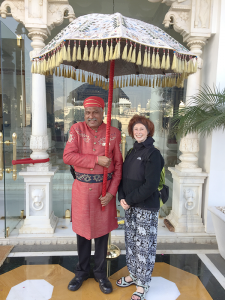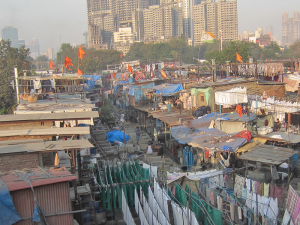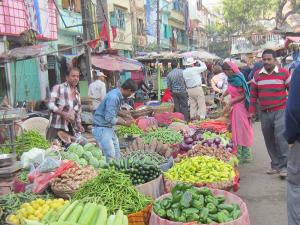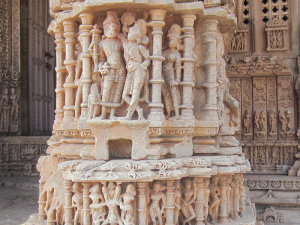India
My visit to this complex, fascinating country
By Marilyn L. Pinsky

Whenever I tell people I have recently been to India, the response is, “why India?” Though it’s a place I had always wanted to visit, my experience was nothing like what I expected it would be.
In my brief three-week visit, this extremely complex, fascinating country, left me with more questions than any other country I have visited. Given that I’m still searching for answers, one article will not suffice and even so, this series will be strictly about my superficial impressions and experiences.
My tour arrived in India at a particularly historic time — the week after the government voided the large denomination 500 and 1,000 rupee notes, causing a shortage of paper bills. Despite a booming economy, a large percentage of business in India is conducted on the black market. The recall was to get at the so-called “black money,” meaning both money for which taxes had not been paid and the large amount of counterfeit bills in circulation.
In order to get the counterfeit bills out of the system and get taxes paid on money that was squirreled away in Swiss bank accounts, the government issued new money. People who didn’t do business electronically or who didn’t even have bank accounts, waited days on endless lines at banks to exchange their life savings into the new money. The banks and ATMs were overwhelmed and ran out of money faster than the new bills were coming in.
For the most part people understood that the system had to change because of all the cheating on taxes, particularly by some of the extremely wealthy, depriving the government of the ability to provide basic services, let alone improve the country. While the wealthy were able to cope better financially because their transactions were electronic, it seemed like every other person, poor or wealthy, did business in cash and that the people who were hurt the most in the short term were small businesses and their poor customers.
Just to give a sense of the trickle-down effect of the recall, let’s look at a village wedding.

Large weddings are an important family tradition in India and a source of income to those involved in the wedding trade. Often, the whole village is invited and the number of attendees can range into the thousands. Parents start saving for the wedding as soon as their daughter is born. Much of the accumulated money is earned “under the table.” When the large denomination notes became worthless literally overnight, weddings either had to be canceled or drastically scaled down. Deposits were lost. Businesses suffered.
Traditionally, the bride has at least three changes of elaborate clothing over a period of three days of celebrating. The groom, beautifully dressed, rides through the streets to the wedding on a decorated horse surrounded by musicians and friends. Now the retail businesses who outfitted the bride, her bridal party and the guests, the tailor who provided the groom’s clothing, the man in the horse-rental business and the musicians, couldn’t be paid. The catering halls and all their vendors, including the small farmers providing the food, the wedding entertainment, the decorations company and the honeymoon hotels were all left holding the bag. And not just for one wedding, but for the foreseeable future of hundreds of canceled or drastically scaled down events.
Nevertheless, million dollar weddings are not unusual in certain social circles, and a most recent one cost $40 million.
From the tourist’s perspective, we felt awful for the people working in the hotels and restaurants, and for the “untouchable” washroom attendants in the airports, train stations and tourist stops, all of whom depended in varying degrees on tips for their income. For those of us who didn’t think to bring $1 bills to use for tips (I will never make that mistake again!) but instead were intending to break US 20s or 50s and change them into rupees once we were in India, we were in a difficult position, as neither banks, ATMs, hotels nor merchants had money to exchange.

Though things are difficult in the short run, the hope is that it will accomplish the purpose of having appropriate taxes paid and also address the serious concerns about counterfeit money being used to finance terrorism.
While we are on the subjects of weddings, something that I found so difficult to understand at first began to sound like a good idea — arranged marriages. This is done in all segments of society. The parents of both the woman and the man are responsible for finding the appropriate marriage partner and for negotiating the terms. After the wedding, the couple moves in with the groom’s parents.
The parents take a lot of factors into consideration when searching for a mate for their child, such as religion, caste, horoscopes, education and professional status.
When you think of it, who knows a child better than a parent?
And as the communities are fairly small, it is easy to find out information about each other. However, this tradition is beginning to slowly change, particularly in the larger cities, and self-arranged marriages are now an option.
In asking a number of people I met on planes or at restaurants about their arranged marriages, all were very open in talking about it and professed to a high level of satisfaction with the tradition.

In modern times the couple usually gets to meet each other, spend some time together and each has the opportunity to consent to the marriage or not. The divorce rate, compared to the US, is very low.
I did love the “matrimonial” ads in the newspapers. They often were under the headings of “Grooms Wanted For” or “Brides Wanted For” and included the caste, the education level, the profession and the appearance of the suitor and the desired appearance of the one being searched for.
The government, in a desire to change the caste system in the country (more on this in another article) is offering inducements, such as gold watches, for people to marry someone in a lower caste. So far there hasn’t been a lot of takers.
To be continued….

